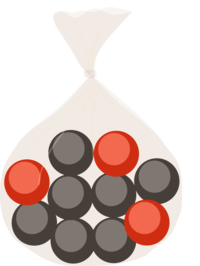Drawing a Ball!
 A bag contains 3 red and 7 black balls. Two balls are selected at random one-by-one without replacement. If the second selected ball happens to be red, what is the probability that the first ball selected is also red?
A bag contains 3 red and 7 black balls. Two balls are selected at random one-by-one without replacement. If the second selected ball happens to be red, what is the probability that the first ball selected is also red?
The above answer in the form of , where and are co-prime positive integers. Submit your answer as
The answer is 11.
This section requires Javascript.
You are seeing this because something didn't load right. We suggest you, (a) try
refreshing the page, (b) enabling javascript if it is disabled on your browser and,
finally, (c)
loading the
non-javascript version of this page
. We're sorry about the hassle.
Relevant wiki: Bayes' Theorem and Conditional Probability
E 1 = First ball drawn is red E 2 = First Ball drawn is black A = Second Ball drawn is red ∴ P ( E 1 ) = 1 0 3 , P ( E 2 ) = 1 0 7 P ( A / E 1 ) = 9 2 , P ( A / E 2 ) = 9 3
⟹ P ( E 1 / A ) = P ( E 1 ) × P ( A / E 1 ) + P ( E 2 ) × P ( A / E 2 ) P ( E 1 ) × P ( A / E 1 ) = 1 0 3 × 9 2 + 1 0 7 × 9 3 1 0 3 × 9 2 = 6 + 2 1 6 = 2 7 6 = 9 2 ∴ b a = 9 2 ⟹ a + b = 2 + 9 = 1 1